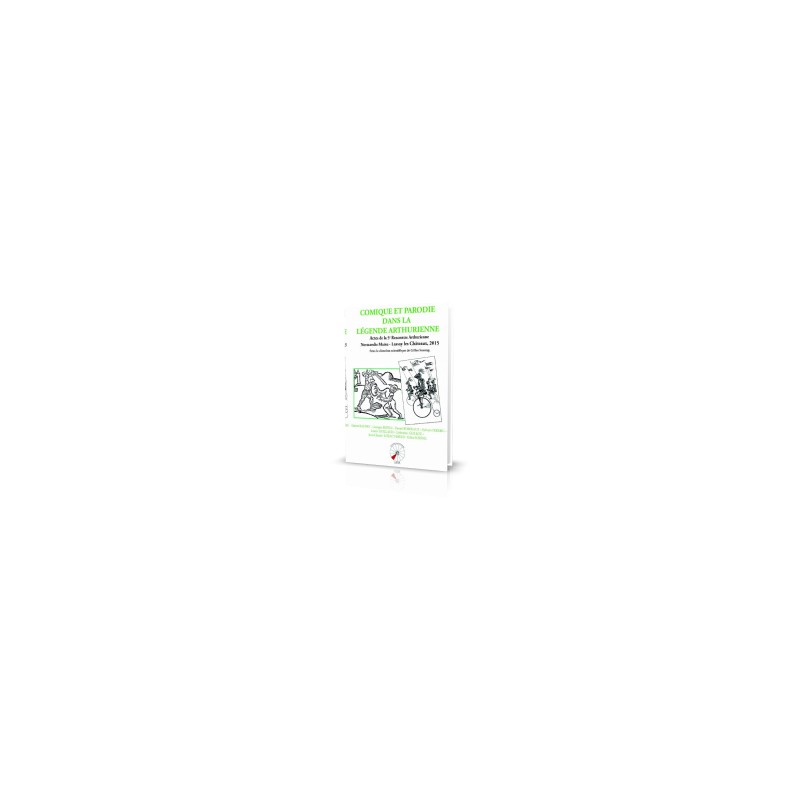



COMIQUE ET PARODIE DANS LA LEGENDE ARTHURIENNE - COLLECTIF
CENA-RENCONTRE ARTHURIENNE NORMANDIE-MAINE 2015
144 pages, format 148 X 210
« L’HUMOUR est sans aucun doute une des caractéristiques fondamentales des romans arthuriens. Le traitement comique des thèmes et des motifs conventionnels n’est pas seulement l’ apanage des œuvres tardives, comme on l’a parfois dit, mais un élément essentiel du genre dès les premières étapes de son développement » (Kate Busby). – Si de plus, comme l’a avancé Philippe Ménard, l’humour des écrivains médiévaux se définit par leur capacité d’auto-dérision, il est alors bien présent dans l’écriture du premier roman arthurien, Kulwch et Olwen, comme le montre ici Jean-Claude Lozac’hmeur. – Quant à l’humour de Chrétien de Troyes, il est particulièrement à l’œuvre dans la dernière partie de son Conte du Graal (aventures de Gauvain), où, note Robert Baudry, l’auteur se parodie lui-même à plusieurs reprises…
Cependant, l’enjeu principal de « l’humour arthurien » (et plus généralement du comique sous toutes ses formes : gab, burlesque, pastiche) ne réside pas simplement dans une volonté avérée de distanciation ironique : Sylvain Ferrieu pointe exhaustivement les très nombreux cas de héros ridiculisés, d’ aventures virant au grotesque où s’atteste la puissance corrosive d’un rire qui aura contribué à la dépréciation progressive des personnages et des valeurs qu’ils incarnaient. – Remplacés par quoi ? Probablement, comme le soutient Daniel Bordeaux à propos du prologue, cette fois, du Conte du Graal, par une leçon d’ordre initiatique, à la fois voilée et suggérée par les apparentes cocasseries qui jalonnent la trajectoire de Perceval.
Enfin, scrutées en profondeur par Lauric Guillaud et Catherine Guillou, deux adaptations « humoristiques » modernes du corpus arthurien– le Yankee de Marc Twain et la série télévisée Kaamelott – exhibent l’arrière-plan lugubre de ce qui commence comme une joyeuse farce et s’assombrit jusqu’à la mise en scène d’une dépression suicidaire ou d’un carnage…prophétique. Tant il est vrai que « le sage », comme disait Bossuet, « ne rit qu’en tremblant ».
“HUMOR is without a doubt one of the fundamental characteristics of Arthurian novels. The comic treatment of conventional themes and motifs is not only the prerogative of late works, as has sometimes been said, but an essential element of the genre from the early stages of its development «(Kate Busby). - If, moreover, as Philippe Ménard has argued, the humor of medieval writers is defined by their capacity for self-mockery, it is then very present in the writing of the first Arthurian novel, Kulwch et Olwen, like the here shows Jean-Claude Lozac’hmeur. - As for the humor of Chrétien de Troyes, it is particularly at work in the last part of his Conte du Graal (adventures of Gauvain), where, notes Robert Baudry, the author parodies himself on several occasions. ...
However, the main stake of «Arthurian humor» (and more generally of comedy in all its forms: gab, burlesque, pastiche) does not simply lie in a proven desire for ironic distancing: Sylvain Ferrieu exhaustively points out the very many cases of ridiculed heroes, of adventures turning to the grotesque where the corrosive power of a laughter attests which will have contributed to the progressive depreciation of the characters and the values they embodied. - Replaced by what? Probably, as Daniel Bordeaux argues with regard to the prologue, this time, of the Tale of the Grail, by an initiatory lesson, both veiled and suggested by the apparent comics that mark Perceval’s trajectory.
Finally, scrutinized in depth by Lauric Guillaud and Catherine Guillou, two modern «humorous» adaptations of the Arthurian corpus - Marc Twain’s Yankee and the Kaamelott television series - exhibit the dismal background of what begins as a joyous farce and s ‘darkens until the scene of a suicidal depression or a carnage… prophetic. So true is it that «the wise man», as Bossuet said, «only laughs while trembling».